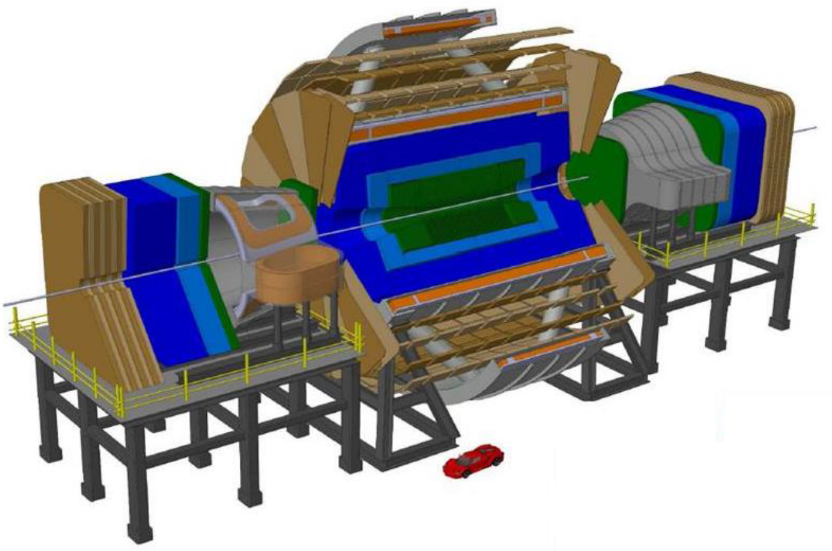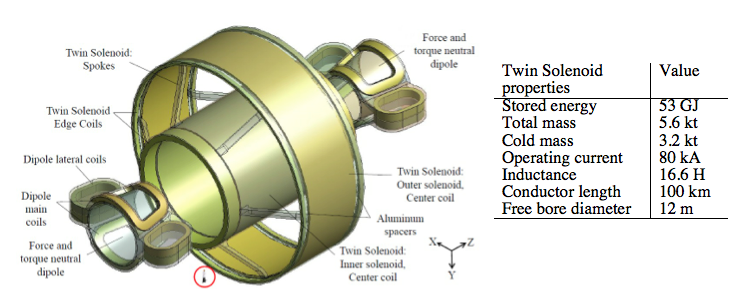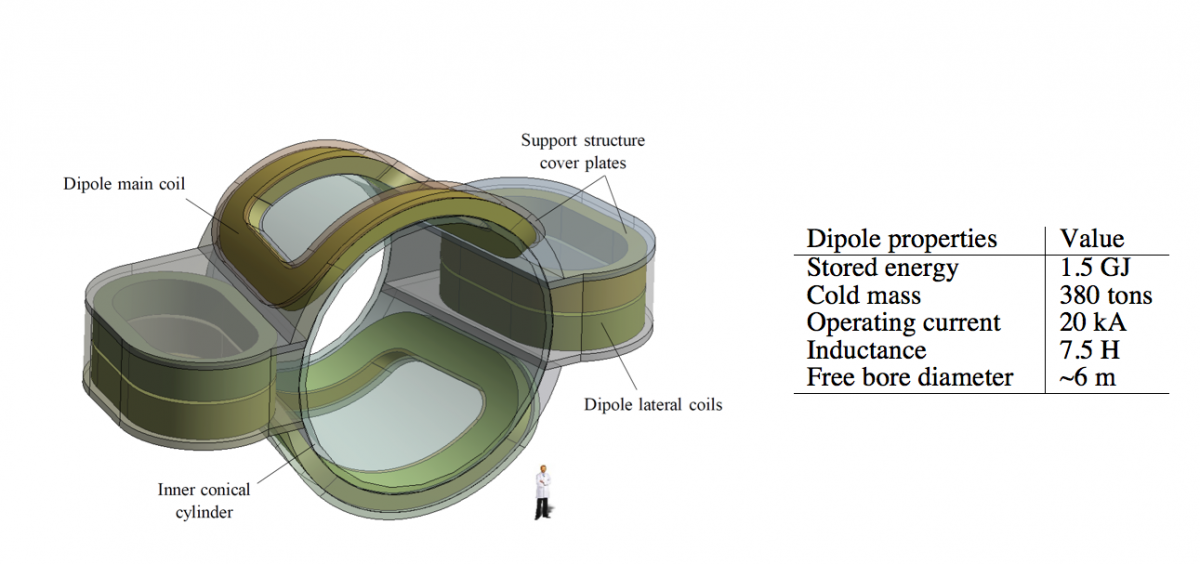Design study of a twin solenoid and dipoles detector magnet system for the FCC study
The Future Circular Collider study for hadron-hadron collisions (FCC-hh) foresees a collision energy of 100 TeV, which is about 7 times higher than the LHC. For the detectors this means that in order to determine the properties of the particles the superconducting detector magnets have to provide stronger magnetic fields over longer distances with respect to ATLAS and CMS.
One of the conceptual detector magnet designs currently being developed for FCC-hh is the “Twin Solenoid”, which features two concentric superconducting solenoids. The inner main solenoid provides an axial magnetic field of 5 to 6 T in a free bore of 10 to 12 meters, while the outer shielding solenoid provides about 3 T in the gap between the solenoids. This outer solenoid serves two purposes: to provide a magnetic field for bending muons, and to minimize the stray field outside the twin solenoid at a minimum, so that magnetic-field-sensitive equipment may be used in close vicinity to the detector magnet. The design presented here is the 6 T version with a free bore of 12 m, which is the most challenging variant.
In terms of size, this system is unlike any detector that currently exists. The stored magnetic energy of 56 GJ and the corresponding cold mass of about 4 kt are over 20 times higher than in the CMS detector; the current record holder with a stored energy of 2.7 GJ and a cold mass of 220 tons. In addition, the system also comprises vacuum vessels, support structure, trackers, calorimeters and muon chambers for a total weight of 20-30 kt.

Figure 1. Overview of the detector design, showing superconducting coils (orange), vacuum vessels (light-grey), beam tube (light-grey), trackers (green), calorimeters (blue), muon chambers (brown) and support structure (dark grey). The two particle beams come from opposite directions through the beam tube and collide in the center of the twin solenoid, resulting in particle products travelling in all directions. The car is added to illustrate the scale of the system.
Detectors operate by magnetically bending the trajectory of particles and subsequently determining the basic properties of each particle from its trajectory and its ability to traverse matter. Thus, after particle beams collide in the center of the detector, the trajectory of the resulting particle products are bent when exposed to a perpendicularly oriented magnetic field, and interact with the trackers and calorimeters which prevent a fraction of them from tunneling through. The properties of muons, which do tunnel through the calorimeters and inner main solenoid, are determined by muon chambers located in between the inner main and outer shielding solenoid.
Bending particles with a solenoidal magnetic field works well for particles travelling in a direction that is perpendicular to the beam but less so for a direction almost parallel to the beam, because the solenoidal field is also oriented parallel to the beam and does not affect the trajectory of the latter. For this purpose, superconducting dipoles are positioned in the forward direction in which the field orientation is perpendicular to the beam so that even the trajectories of particles travelling in the forward direction obtain a curvature. The concept of combining solenoids with dipoles for providing curvature to particles regardless of their direction is referred to as ‘full coverage’. The twin solenoid and dipoles design provides full coverage with magnetic field integrals of 36 Tm in the free bore for particles travelling perpendicular to the beam and 10 Tm for particles travelling parallel to the beam.

Figure 2. Twin solenoid & dipoles design features two superconducting concentric solenoids in the center in combination with force and torque neutral superconducting dipoles. The overall length of the system is 43 m and the overall diameter is 27 m.
The combination of solenoids and dipoles in close vicinity presents a major engineering challenge. The magnetic fields exerted by a dipole and a solenoid are oriented perpendicular to each other whereas an alignment of the magnetic fields is energetically more favorable. Ordinarily this would result in a large transverse force and a very large torque on both the solenoid and the dipole. In this design however, the dipoles combine main dipole coils with lateral dipole coils where the geometry of the lateral dipole coils is optimized to not only reduce the stray field but also bring the net torque and force on the dipole to practically zero. In a similar fashion the inner and outer coils of the twin solenoid are placed in a force and torque neutral position with respect to each other and strong supports counter any forces resulting from misalignment.

Figure 3. Force & Torque – neutral dipole. The superconducting coils are indicated in green. The lateral coils are located next to the main coils for the purposing of reducing the stray field and bringing the net force and torque on the dipole to zero.
A second challenge in conceiving the design is the presence of competing criteria. For example, reducing the overall weight of the detector magnet has several benefits, such as reducing the requirements on the crane needed for lowering the system down to the detector cavern, but it also means that the stresses in the windings will be higher. Another example is that placing the dipole further away from the twin solenoid would reduce the stresses in the cold mass of the dipole resulting from the solenoidal field, but would also increase the overall size of the system. In this preliminary design a relatively low mass is assumed where the feasibility of the stress level in the conductor is subject of ongoing research, and the dipole is placed within a few meters of the twin solenoid.
An animation prepared by Helder Filipe Pais Da Silva showing the assembly of the FCC-hh detector based on the preliminary design concept.
In summary, the twin solenoid & dipoles detector magnet assembly features a combination of very large superconducting magnets, with a total stored magnetic energy that exceeds that of current detector magnet systems by a significant margin. The unique configuration provides substantial bending power for particles travelling in all directions. The system is finely balanced in terms of the forces and torques and the overall performance of the system meets the preliminary requirements for a future FCC-hh detector.
For more details: M. Mentink et al., “Design of a 56 GJ Twin Solenoid & Dipoles Detector Magnet System for the Future Circular Collider”, http://snf.ieeecsc.org/abstracts/design-56-gj-twin-solenoid-dipoles-detector-magnet-system-future-circular-collider-winner
